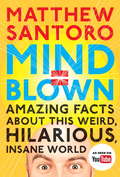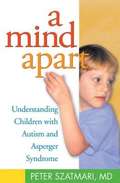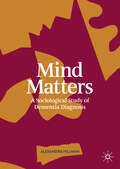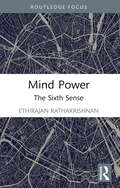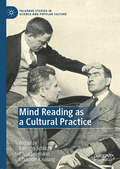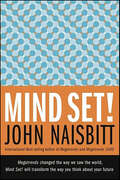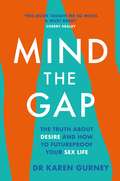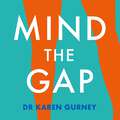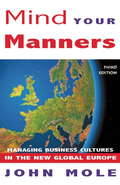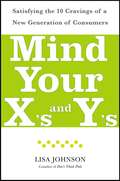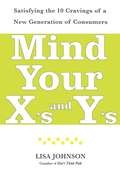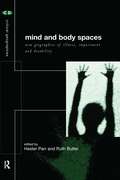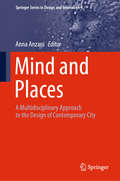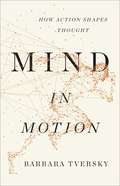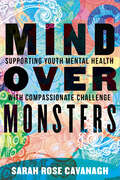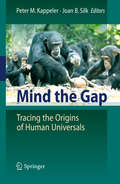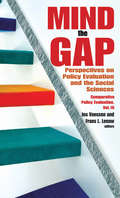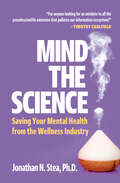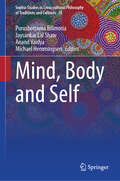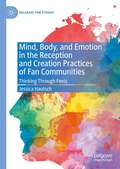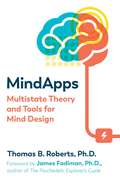- Table View
- List View
Mind = Blown: Amazing Facts About This Weird, Hilarious, Insane World
by Matthew SantoroMatthew Santoro's originality and humor has attracted millions of fans, making him a beloved YouTube star. His weekly videos on amazing and little-known facts are eagerly anticipated by his many subscribers and followers around the world. In his first-ever book, Matthew's love of weird and wacky knowledge explodes with new facts and stories from around the planet, and beyond. Surprising, and always entertaining, Mind = Blown offers even more of Matthew's unique take on this hilarious, crazy world: The most ridiculous laws from past and presentCrazy doppelgangers of people, places, and unexpected thingsHistorical wizards who actually livedReal-life animal avengersAnd a special section: Japan Blows My Mind!From shin-kicking competitions and beer pong-playing robots, to enormous fire-balls shooting through space, you won't believe what you'll discover in Mind = Blown. But beware: there is too much astounding trivia for any one mind to contain!From the Trade Paperback edition.
Mind Apart
by Peter SzatmariWhy would a child refuse to talk about anything but wasp wings-or the color of subway train doors? What does it mean when a nine-year-old asks questions about death hundreds of times a day? And how can parents build a close relationship with a little girl who hates to be touched? In this compassionate book, leading autism authority Dr. Peter Szatmari shows that children with autism spectrum disorders act the way they do because they think in vastly different ways than other people. Dr. Szatmari shares the compelling stories of children he has treated who hear everyday conversation like a foreign language or experience hugs like the clamp of a vise. Understanding this unusual inner world-and appreciating the unique strengths that thinking differently can bestow-will help parents relate to their children more meaningfully, and make the "outer world" a less scary place.
Mind Matters: A Sociological Study of Dementia Diagnosis
by Alexandra HillmanAs population aging spreads to more parts of the world, dementia is fast becoming one of the most common and feared conditions of our time. Diagnosis has been identified as a key point of intervention for both biomedical and policy agendas. Drawing on ethnographic research spanning more than a decade, this book reflects on observations and recordings of UK memory clinic consultations, interview accounts with clinical staff involved in assessment and diagnosis, internationally recognised dementia researchers, and people living with dementia and their families both at the point of diagnosis and as their condition progresses. In dialogue with accounts and observations from the field, this book makes the case for the development of a sociology of dementia diagnosis. In doing so, the book progresses a dialectic approach to the study of dementia&’s construction and experience and contextualises dementia diagnosis within wider networks of meaning and systems of value related to aging, health, and personhood.
Mind Power: The Sixth Sense
by Ethirajan RathakrishnanThis book explores the mysteries of the human brain and the potential of the mind. The peculiarities and infinitude of the mind have been a theme for research for scientists and philosophers alike, for centuries. This volume presents the unanswered and highly convoluted questions and hypotheses surrounding the human mind in a simplified way. It examines the binaries of religion and science, god and nature and emotions and intelligence through a philosophical lens to posit that the relationships between cognition, belief, nature and science are what we understand and infer based on our surroundings and how much we are willing to think, learn and introspect.This book will be of interest to students of philosophy, psychology, science, popular science, psychoanalysis, cognitive studies and mental health. It will also appeal to general readers.
Mind Reading as a Cultural Practice (Palgrave Studies in Science and Popular Culture)
by Laurens Schlicht Carla Seemann Christian KassungThis book provides a genealogical perspective on various forms of mind reading in different settings. We understand mind reading in a broad sense as the twentieth-century attempt to generate knowledge of what people held in their minds – with a focus on scientifically-based governmental practices. This volume considers the techniques of mind reading within a wider perspective of discussions about technological innovation within neuroscience, the juridical system, “occult” practices and discourses within the wider field of parapsychology and magical beliefs. The authors address the practice of, and discourses on, mind reading as they form part of the consolidation of modern governmental techniques. The collected contributions explore the question of how these techniques have been epistemically formed, institutionalized, practiced, discussed, and how they have been used to shape forms of subjectivities – collectively through human consciousness or individually through the criminal, deviant, or spiritual subject. The first part of this book focuses on the technologies and media of mind reading, while the second part addresses practices of mind reading as they have been used within the juridical sphere. The volume is of interest to a broad scholarly readership dealing with topics in interdisciplinary fields such as the history of science, history of knowledge, cultural studies, and techniques of subjectivization.
Mind Set!: Eleven Ways to Change the Way You See—and Create—the Future
by John NaisbittIn his seminal works Megatrends and Megatrends 2000, John Naisbitt proved himself one of the most far-sighted and accurate observers of our fast-changing world. Mind Set! goes beyond that by disclosing the secret of forecasting. Naisbitt gives away the keys to the kingdom, opening the door to the insights that let him understand today's world and see the opportunities of tomorrow. He selects his most effective tools, 11 Mindsets, and applies them by guiding the reader through the five forces that will dominate the next decades of the twenty-first century. Illustrated by stories about Galileo and Einstein to today's icons and rebels in business, science, and sports, Mind Set! opens your eyes to see beyond media headlines, political slogans, and personal opinions to select and judge what will form the pictures of the future.
Mind The Gap: The truth about desire and how to futureproof your sex life
by Dr Karen Gurney'This book taught me so much about female desire. A must read!' Cherry HealeyDid you know that there is an orgasm gap of around 30% between heterosexual couples when they have sex? In Mind The Gap, Dr Karen Gurney, a clinical psychologist and certified psychosexologist, explores not just this gap, but the gaps in our knowledge of so much of the most important new science around sex and desire. In this book, you will learn that nearly everything that you've been led to believe about female sexuality isn't actually true. And that, despite what you might think, it is possible to simultaneously feel little to no spontaneous desire and have a happy and mutually satisfying sex life long term.Exploring the mismatch between ideas about sex in our society and what the science tells us, Mind The Gap also explains how this disconnect lies at the root of many of our sexual problems. Combining science with case studies, practical exercises and tips, this is a book for anyone who wants to better understand the mechanics of desire and futureproof their sex life, for life.
Mind The Gap: The truth about desire and how to futureproof your sex life
by Dr Karen Gurney'This book taught me so much about female desire. A must read!' Cherry HealeyDid you know that there is an orgasm gap of around 30% between heterosexual couples when they have sex? In Mind The Gap, Dr Karen Gurney, a clinical psychologist and certified psychosexologist, explores not just this gap, but the gaps in our knowledge of so much of the most important new science around sex and desire. In this book, you will learn that nearly everything that you've been led to believe about female sexuality isn't actually true. And that, despite what you might think, it is possible to simultaneously feel little to no spontaneous desire and have a happy and mutually satisfying sex life long term.Exploring the mismatch between ideas about sex in our society and what the science tells us, Mind The Gap also explains how this disconnect lies at the root of many of our sexual problems. Combining science with case studies, practical exercises and tips, this is a book for anyone who wants to better understand the mechanics of desire and futureproof their sex life, for life.
Mind The Gap: The truth about desire and how to futureproof your sex life
by Dr Karen GurneyDid you know that there is an orgasm gap of around 30% between heterosexual couples when they have sex? In Mind The Gap, Dr Karen Gurney, a clinical psychologist and certified psychosexologist, explores not just this gap, but the gaps in our knowledge of so much of the most important new science around sex and desire. In this audiobook, you will learn that nearly everything that you've been led to believe about female sexuality isn't actually true. And that, despite what you might think, it is possible to simultaneously feel little to no spontaneous desire and have a happy and mutually satisfying sex life long term.Exploring the mismatch between ideas about sex in our society and what the science tells us, Mind The Gap also explains how this disconnect lies at the root of many of our sexual problems. Combining science with case studies, practical exercises and tips, this is an audiobook for anyone who wants to better understand the mechanics of desire and futureproof their sex life, for life.(P)2020 Headline Publishing Group Ltd
Mind Your Colour
by V. A. FebruaryThis book is essentially about stereotypes as found in the literature and culture of South Africa. It deals specifically with those people referred to in the South African racial legislation as ‘coloureds’. The book is also an illustration of the way in which stereotypes function as a means of social control and repression. First published in 1981. Routledge is an imprint of Taylor & Francis, an informa company.
Mind Your Manners
by John MoleUnderstanding the nature of cultural diversity is one thing-managing it day-to-day is quite another! When doing business internationally, culture shock-and sometimes culture clash-is unavoidable. John Mole's Mind Your Manners: Managing Business Cultures in the New Global Europe is a comprehensive guide that explores cultural aspects of dozens of individual European countries as they relate to global business. Now in a fully expanded and updated third edition, Mind Your Manners includes every countriy-from the Baltics to the Balkans-applying for membership to the European Union, the world's biggest global market, and many others.Based on interviews, surveys, and workshops with over a thousand managers (of fifty nationalities), Mind Your Manners describes Europe's extraordinary political, economic, and social changes and their effects on the way we work together. New chapters on diversity, change, body language, and negotiation identify the key elements that shape the business and cultural environment of the continent, and Euroquizzes will test your knowledge and demonstrate the broad cultural spectrum of European nations. More than a mere catalog, Mind Your Manners is a must-read for anyone who intends to succeed in the European Union.
Mind Your X's and Y's
by Lisa Johnson Cheri HansonToday's 18-to-40-year-olds make for a notoriously elusive group of consumers: they're savvy, sophisticated, and particular. They're all but immune to traditional advertising and have an instinctive sense of quality and fair pricing. Inundated with choices, they are drawn to brands that satisfy not just what they need, but what they crave. At the same time, these consumers are spending money like it's going out of style. Generation X has firmly refuted its slacker reputation and is nearing the height of its earning potential. Generation Y has more buying power than any previous generation of teens and twentysomethings. But how to win their attention and loyalty? In "Mind Your X's and Y's", Lisa Johnson proves that the buying habits of 18-to-40-year-olds can be anticipated. Johnson, coauthor of "Don't Think Pink" and a leading marketing consultant, pinpoints the new rules of engagement for this Connected Generation. Based on her own and others' groundbreaking research, she looks into the heart of the Gen X and Y psyche to identify its ten core cravings -- for adventure, for high-concept design, for new families and social networks, and for personal storytelling, to name a few. This revolutionary book is packed with fascinating case studies of established and breakaway brands from every major industry, interviews with dozens of maverick thinkers and hundreds of consumers, and numerous revealing statistics. Johnson analyzes the scope of each craving to determine how it drives specific buying behaviors and offers relevant data that illustrate its impact. Mind Your X's and Y's equips anyone who wants to reach these consumers -- brand managers and their advertising, online, creative, packaging, events, and promotions teams; small-business owners and their marketing staff; advertising agencies and specialists -- with the know-how to transform market research into profitable strategies. Members of Generations X and Y are the most coveted and hard-to-reach consumers in the marketplace. Mind Your X's and Y's is a master class in how to create compelling brands for this Connected Generation.
Mind Your X's and Y's
by Lisa JohnsonToday's 18-to-40-year-olds make for a notoriously elusive group of consumers: they're savvy, sophisticated, and particular. They're all but immune to traditional advertising and have an instinctive sense of quality and fair pricing. Inundated with choices, they are drawn to brands that satisfy not just what they need, but what they crave. At the same time, these consumers are spending money like it's going out of style. Generation X has firmly refuted its slacker reputation and is nearing the height of its earning potential. Generation Y has more buying power than any previous generation of teens and twentysomethings. But how to win their attention and loyalty? In Mind Your X's and Y's, Lisa Johnson proves that the buying habits of 18-to-40-year-olds can be anticipated. Johnson, coauthor of Don't Think Pink and a leading marketing consultant, pinpoints the new rules of engagement for this Connected Generation. Based on her own and others' groundbreaking research, she looks into the heart of the Gen X and Y psyche to identify its ten core cravings -- for adventure, for high-concept design, for new families and social networks, and for personal storytelling, to name a few. This revolutionary book is packed with fascinating case studies of established and breakaway brands from every major industry, interviews with dozens of maverick thinkers and hundreds of consumers, and numerous revealing statistics. Johnson analyzes the scope of each craving to determine how it drives specific buying behaviors and offers relevant data that illustrate its impact. Mind Your X's and Y's equips anyone who wants to reach these consumers -- brand managers and their advertising, online, creative, packaging, events, and promotions teams; small-business owners and their marketing staff; advertising agencies and specialists -- with the know-how to transform market research into profitable strategies. Members of Generations X and Y are the most coveted and hard-to-reach consumers in the marketplace. Mind Your X's and Y's is a master class in how to create compelling brands for this Connected Generation.
Mind and Body Spaces: Geographies of Illness, Impairment and Disability (Critical Geographies #Vol. 1)
by Hester Parr Ruth ButlerMind and Body Spaces highlights new international research from Britain, USA, Canada and Australia, on bodily impairment, mental health and disabled peoples social worlds. The contributors discuss a variety of current issues including:* historical conceptions of the body and behaviour* contemporary political activism* matters of identity and employment* accessible housing* parenthood and child carers* psychiatric medication use* masculinity and sexuality* autobiography* social exclusion and inclusion. The contributors are: Hester Parr, Ruth Butler, Rob Imrie, Michael L. Dorn, Deborah Carter Park, John Radford, Brendan Gleeson, Isabel Dyck, Edward Hall, Pamela Moss, Gill Valentine, Christine Milligan, Flora Gathorne-Hardy, Jane Stables, Fiona Smith and Vera Chouinard.
Mind and Places: A Multidisciplinary Approach to the Design of Contemporary City (Springer Series in Design and Innovation #4)
by Anna AnzaniThis book explores the contributions of psychological, neuroscientific and philosophical perspectives to the design of contemporary cities. Pursuing an innovative and multidisciplinary approach, it addresses the need to re-launch knowledge and creativity as major cultural and institutional bases of human communities. Dwelling is a form of knowledge and re-invention of reality that involves both the tangible dimension of physical places and their mental representation. Findings in the neuroscientific field are increasingly opening stimulating perspectives on the design of spaces, and highlight how our ability to understand other people is strongly related to our corporeity. The first part of the book focuses on the contributions of various disciplines that deal with the spatial dimension, and explores the dovetailing roles that science and art can play from a multidisciplinary perspective. In turn, the second part formulates proposals on how to promote greater integration between the aesthetic and cultural dimension in spatial design. Given its scope, the book will benefit all scholars, academics and practitioners who are involved in the process of planning, designing and building places, and will foster an international exchange of research, case studies, and theoretical reflections to confront the challenges of designing conscious places and enable the development of communities.
Mind in Motion: How Action Shapes Thought
by Barbara TverskyAn eminent psychologist offers a major new theory of human cognition: movement, not language, is the foundation of thoughtWhen we try to think about how we think, we can't help but think of words. Indeed, some have called language the stuff of thought. But pictures are remembered far better than words, and describing faces, scenes, and events defies words. Anytime you take a shortcut or play chess or basketball or rearrange your furniture in your mind, you've done something remarkable: abstract thinking without words. In Mind in Motion, psychologist Barbara Tversky shows that spatial cognition isn't just a peripheral aspect of thought, but its very foundation, enabling us to draw meaning from our bodies and their actions in the world. Our actions in real space get turned into mental actions on thought, often spouting spontaneously from our bodies as gestures. Spatial thinking underlies creating and using maps, assembling furniture, devising football strategies, designing airports, understanding the flow of people, traffic, water, and ideas. Spatial thinking even underlies the structure and meaning of language: why we say we push ideas forward or tear them apart, why we're feeling up or have grown far apart. Like Thinking, Fast and Slow before it, Mind in Motion gives us a new way to think about how--and where--thinking takes place.
Mind over Monsters: Supporting Youth Mental Health with Compassionate Challenge
by Sarah Rose CavanaghAn investigation into the mental health crisis affecting young adults today, and an impassioned argument for creating learning environments characterized both by compassion and challenge.Alarming statistics in recent years indicate that mental health problems like depression and anxiety have been skyrocketing among youth. To identify solutions, psychologist and professor Sarah Rose Cavanagh interviews a roster of experts across the country who are dedicating their lives to working with young people to help them actualize their goals, and highlights voices of college students from a range of diverse backgrounds.Cavanagh also brings the reader on an invigorating tour of pedagogical, neuroscientific, and psychological research on mental health—one that involves her own personal journey from panic to equilibrium.The result of these combined sources of inquiry indicates that to support youth mental health, we must create what Cavanagh calls compassionate challenge— first, we need to cultivate learning and living environments characterized by compassion, and then, we need to guide our youth into practices that encourage challenge, helping them face their fears in an encouraging, safe, and even playful way.Mind over Monsters is a must-read for teachers, administrators, parents, and young people themselves.
Mind the Gap
by Joan Silk Peter KappelerWhat makes us human? What made us become the way we are? One way to answer these questions is to identify the traits that all humans share, traits that are universal features of all human societies. Another way to do so is to ask how humans differ from other species, particularly from our closest relatives, the nonhuman primates. The contributors to this book pursue both approaches, in an effort to understand how evolution has shaped modern human behavior and societies.
Mind the Gap: Perspectives on Policy Evaluation and the Social Sciences (Comparative Policy Evaluation Ser.)
by Jos VaessenOver the past twenty to thirty years, evaluation has become increasingly important to the field of public policy. The number of people involved and specializing in evaluation has also increased markedly. Evidence of this trend can be found in the International Atlas of Evaluation, the establishment of new journals and evaluation societies, and the increase in systems of evaluation. Increasingly, the main reference point has become an assessment of the merit and value of interventions as such rather than the evaluator's disciplinary background. This growing importance of evaluation as an activity has also led to an increasing demand for the type of competencies evaluators should have.Evaluation began as a niche area within the social and behavioral sciences. It subsequently became linked to policy research and analysis, and has, more recently, become trans-disciplinary. This volume demonstrates an association between the evaluation tradition in a particular country or policy field and the nature of the relationship between social and behavioral science research and evaluative practice. This book seeks to offer comprehensive data, which lead to conclusions about patterns that transcend the gap between evaluation and the social scientific disciplines.Mind the Gap has a twofold aim. The first is to highlight and characterize the gap between evaluation practices and debates, and the substantive knowledge debates within the social and behavioral sciences. The second is to show why this gap is problematic for the practice of evaluation, while at the same time illustrating possible ways to build bridges. The book is centered on the value of producing useful evaluations grounded in social science theory and research.
Mind the Science: Saving your Mental Health from the Wellness Industry
by Jonathan N. SteaA clinical psychologist who regularly deals with some of society's most vulnerable exposes and debunks the predatory pseudoscience and grift of the multi-trillion-dollar wellness industry and points us towards a better way to take care of our mental health.Can the unbroken gaze of a lone man on a stage in front of hundreds of people truly alleviate their mental distress? Can Berlin Wall pills or a coffee enema cure depression? Can we improve our mental health with past-life regression therapy, cold-water shock therapy, rebirthing therapy? Wellness grifters and alternative-health snake oil salesmen are everywhere these days, and when our medical systems are under stress (and we are, too!) these costly purveyors of false hope are worse than a waste of money—they can lead us to delay badly needed care from real professionals, exacerbate our conditions and, in the most tragic of cases, even kill us. Today, people looking to care for their mental health face a market with at least 600 &“brands&” of psychotherapy—and counting. Most are ineffective, and many could be harmful. There exist countless unregulated providers of mental health services in the $5.6 trillion USD wellness industry and alternative medicine community looking to exploit people&’s financial and emotional vulnerabilities. The world of mental health care is very much caveat emptor: buyer beware. Having seen so many of his patients hurt by the pseudoscience circulating in the industry, Dr. Jonathan N. Stea is on a mission to expose its harm and protect the public from mental health misinformation. In a landscape of rampant burnout and at a time when mental health concerns are at a fever pitch, Mind the Science provides hope and real information to those who have been touched by mental illness, have been misled by false marketing, or are simply curious about the relationship between science and mental health.
Mind, Body and Self (Sophia Studies in Cross-cultural Philosophy of Traditions and Cultures #38)
by Purushottama Bilimoria Michael Hemmingsen Jaysankar Lal Shaw Anand VaidyaThis book is a unique collaboration of philosophers from across the world bringing together contemporary concepts of consciousness, the Māori conception of self, as well as Indian and Buddhist concepts of self and mental states. Contemporary concepts of consciousness include higher-order consciousness and phenomenological approaches. The idea behind this volume came from an international conference on ‘Mind, Body and Self’ held at Victoria University of Wellington; organized by the Society for Philosophy and Culture. The authors herein contribute to the relationship between concepts of self, mind, and body. The wide variety of contributors from across cultural backgrounds adds to a diverse and valuable conversation on the nature of human existence and thoughts of self. This book appeals to students and researchers working in philosophy and religious studies.
Mind, Body, and Emotion in the Reception and Creation Practices of Fan Communities: Thinking Through Feels (Palgrave Fan Studies)
by Jessica HautschThis book argues that fans’ creative works form a cognitive system; fanfic, fanvids, and gifs are not simply evidence of thinking, but acts of thinking. Drawing on work in cognitive linguistics, neuroscience, cognitive philosophy, and psychology—particularly focused on 4-E cognition, which rejects Cartesian dualism–this project demonstrates that cognition is an embodied, emotional, and distributed act that emerges from fans’ interactions with media texts, technological interfaces, and fan collectives. This mode of textual engagement is deeply physical, emotional, and social and is enacted through fanworks. By developing a theory of critical closeness, this book proposes a methodology for fruitfully putting cognitive science in conversation with fan studies.
Mind, Machine, And Metaphor: An Essay On Artificial Intelligence And Legal Reasoning
by Alexander E. SilvermanMind, Machine, and Metaphor is a rich, original, and wide-ranging view of legal theory in the context of artificial intelligence (AI) research. It is essential reading for legal theorists and for legal scholars and students of AI with an interest in each other's fields.
Mind, Materiality and History: Explorations in Fijian Ethnography (Material Cultures)
by Christina TorenHow do we become who we are? How is it that people are so similar in the ways they differ from one another, and so different in the ways they are the same?Christina Toren's theory of mind as not only a physical phenomenon, but an historical one, sets out to answer these questions by examining how the material world of objects and other people informs the constitution of mind in persons over time.This theory of embodied mind as a microhistorical process is set out in the first chapter, providing a context for the nine papers that follow. Questions explored include the way meaning-making processes reference an historically specific world and are responsible at once for continuity and change, how ritual informs children's constitution of the categories adults use to describe the world, and how people represent their relationships with one another and in so doing come to embody history.Mind, Materiality and History has direct relevance to current debates on the nature of mind and consciousness, and demonstrates the centrality of the study of children to social analysis. It will be a valuable resource for students and scholars with an interest in anthropological theory and methodology, as well as those engaged in material culture studies.
Mindapps: Multistate Theory and Tools for Mind Design
by Thomas B. RobertsAn exploration of “mind design” technologies and practices--mindapps--that boost intellectual capacity and enable new ways of thought and action • Reveals how mindapps transform the patterns of our mind-body complex and help generate new ideas by enabling access to new mind states • Examines the singlestate fallacy--the myth that useful thinking only occurs in our ordinary awake mental state • Explores a wealth of mindapp practices and techniques, including microdosing with psychedelics, yoga and martial arts, hypnosis, breathing techniques, lucid dreaming, rites of passage, biofeedback and neurofeedback, and transcranial brain stimulation Just as we can write and install apps in our electronic devices, we can construct “mindapps” and install them in our brain-mind complex, and as just as digital apps add capabilities to our devices, mindapps can expand our mental powers and creative abilities, allowing us to intentionally redesign our minds. Using psychedelics as the prime example, Thomas B. Roberts explores the many different kinds of mindapps, including meditation, other psychoactive plants and chemicals, sensory overload and deprivation, biofeedback and neurofeedback, hypnosis and suggestion, sleep and lucid dreaming, creative imagery, transcranial brain stimulation and optical brain stimulation, rites of passage, martial arts and exercise routines, yoga, breathing techniques, and contemplative prayer. He also looks at the future of mindapps, the potential for new mindapps yet to be invented, and how installing multiple mindapps can produce new, yet to be explored mind states. Drawing on decades of research, he shows how psychedelics in particular are “ideagens”--powerful tools for generating new ideas and new ways of thinking. Uniting the many forms of mindapps into one overall Multistate Mind Theory, Roberts examines the singlestate fallacy--the myth that useful thinking only occurs in our ordinary awake mental state--and demonstrates the many mind-body states we are capable of. He shows how mindapps not only allow us to design and redesign our own minds but also offer benefits for artistic performance, mystical and spiritual experience, and scientific research by improving creativity, open-mindedness, problem solving, and inner-brain connections. Reformulating how we think about the human mind, Mindapps unveils the new multistate landscape of the mind and how we can each enter the world of mind design.
